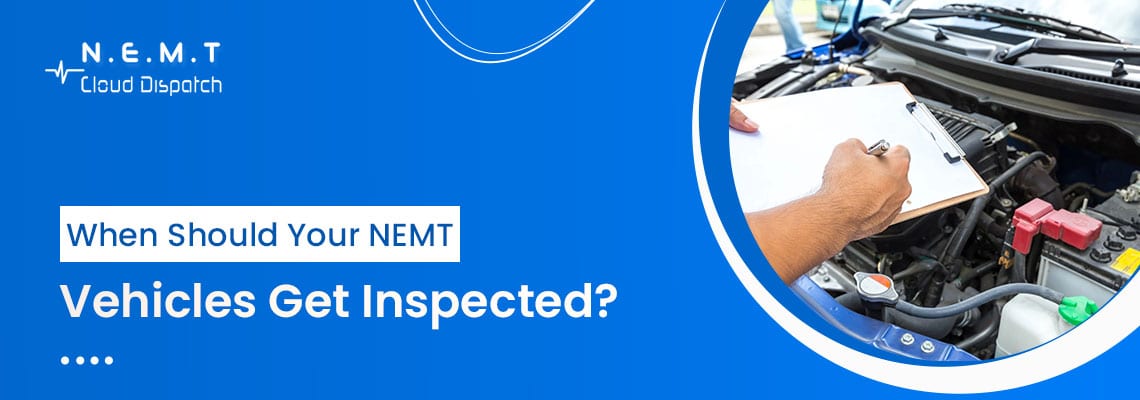Non-emergency medical transportation (NEMT) plays a critical role in ensuring patients reach their medical appointments safely and on time. For NEMT providers, maintaining a reliable and safe fleet is not just a regulatory requirement it’s essential for patient trust and operational efficiency. One of the most common questions fleet managers ask is: “When should NEMT vehicles get inspected?”
In this guide, brought to you by NEMT Cloud Dispatch, we break down the essential inspection schedules, safety checklists, and best practices to help your fleet remain compliant, safe, and fully operational.
Why Regular NEMT Vehicle Inspections Are Crucial
Fleet inspections are more than just a compliance formality. They:
Reduce the risk of accidents and mechanical failures.
Ensure ADA compliance for accessible transportation.
Improve passenger confidence in your services.
Lower long-term maintenance costs by catching issues early.
By integrating inspection routines with NEMT Cloud Dispatch software, operators can streamline scheduling, automate maintenance reminders, and track inspection histories all in one platform.
When Should NEMT Vehicles Get Inspected? Key Guidelines
The timing of inspections depends on multiple factors, including vehicle type, usage frequency, and state or federal requirements. Here’s a breakdown:
1. Daily Pre-Trip Inspections
Every NEMT vehicle should undergo a daily pre-trip inspection before leaving the depot. Key checks include:
Brakes and tire condition
Lights and signals
Seat belts and accessibility equipment
Fluid levels (oil, coolant, brake fluid)
Cleanliness and sanitation
These daily checks, also referred to as NEMT daily pre‑trip inspection tips, help catch small issues before they escalate into costly repairs.
2. Routine Maintenance Inspections
Routine inspections should align with mileage milestones or time intervals. Standard practices include:
Every 3,000–5,000 miles: oil changes, fluid checks, and tire rotations
Every 10,000–15,000 miles: brake system inspection and suspension check
Every 20,000–25,000 miles: comprehensive safety and mechanical evaluation
Following a NEMT vehicle inspection schedule best practices ensures your fleet operates efficiently while remaining compliant with safety regulations.
3. State vs Federal NEMT Vehicle Inspection Requirements
Different jurisdictions enforce state vs federal NEMT vehicle inspection requirements. Operators must ensure:
Vehicles meet local Department of Transportation (DOT) inspections.
ADA-compliant vehicles are regularly checked for lifts, ramps, and securement systems.
Federal safety standards are adhered to if transporting patients across state lines.
With NEMT Cloud Dispatch, fleet managers can automatically track inspection schedules according to both state and federal rules, reducing compliance risks.
4. Periodic Comprehensive Inspections
Periodic inspections, often conducted quarterly or semi-annually, should cover:
Engine and transmission performance
Exhaust and emissions systems
HVAC functionality
Safety and emergency equipment
Interior accessibility and comfort
Using a NEMT vehicle safety and maintenance checklist during these inspections helps standardize quality across your fleet.
How Often to Inspect NEMT Fleet Vehicles?
The frequency of inspections depends on vehicle use and condition:
| Inspection Type | Recommended Frequency |
|---|---|
| Daily pre-trip inspection | Every shift |
| Routine maintenance | Every 3,000–25,000 miles |
| Comprehensive inspection | Quarterly or semi-annually |
| ADA compliance check | Monthly or as required |
| Regulatory DOT inspections | Per state/federal schedule |
Maintaining a consistent schedule ensures your fleet is always ready for service, reduces downtime, and prevents costly repairs.
ADA Compliance Vehicle Inspections for NEMT
Accessibility is a cornerstone of NEMT services. ADA-compliant inspections include:
Wheelchair lifts and securements
Ramp operation and integrity
Handrails, flooring, and step safety
Audio/visual safety alerts for passengers
Documenting ADA checks within your NEMT vehicle safety and maintenance checklist is essential for legal compliance and enhancing passenger experience.
Leveraging Technology for Efficient Inspections
Manual tracking of inspections can be cumbersome and error-prone. NEMT Cloud Dispatch provides powerful tools to simplify this process:
Automated inspection reminders for drivers and fleet managers
Digital logging of daily pre-trip checks
Integrated ADA compliance tracking
Maintenance history and reporting for audits
By using NEMT Cloud Dispatch, you can improve fleet reliability, reduce human error, and ensure how often to inspect NEMT fleet vehicles is always up-to-date.
Tips for Maximizing Inspection Efficiency
To get the most out of your inspections:
Standardize Checklists – Use consistent NEMT vehicle safety and maintenance checklist templates for all vehicles.
Train Drivers – Educate drivers on NEMT daily pre‑trip inspection tips.
Automate Reminders – Leverage dispatch software for scheduling inspections and alerts.
Track Compliance – Monitor both state vs federal NEMT vehicle inspection requirements in one dashboard.
Document Everything – Keep digital records for audits, insurance, and quality assurance.
Conclusion: Stay Ahead with Proper NEMT Vehicle Inspections
Knowing when should NEMT vehicles get inspected is not just a regulatory task it’s a key part of running a safe, reliable, and efficient NEMT service. By following a structured NEMT vehicle inspection schedule best practices, using a comprehensive NEMT vehicle safety and maintenance checklist, and leveraging technology like NEMT Cloud Dispatch, fleet operators can ensure every trip is safe, compliant, and smooth.
Ensure Your NEMT Fleet is Always Safe & Compliant
Streamline your NEMT vehicle inspections, track ADA compliance, and automate maintenance schedules with NEMT Cloud Dispatch. Keep your fleet safe, reduce downtime, and stay compliant effortlessly.
Request a Demo

